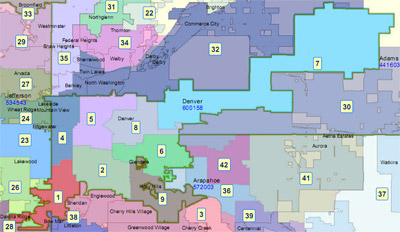
President (To Win Colorado)
See Full Big Line
(D) Kamala Harris
(R) Donald Trump
80%
20%

CO-01 (Denver)
See Full Big Line
(D) Diana DeGette*
(R) V. Archuleta
98%
2%

CO-02 (Boulder-ish)
See Full Big Line
(D) Joe Neguse*
(R) Marshall Dawson
95%
5%

CO-03 (West & Southern CO)
See Full Big Line
(D) Adam Frisch
(R) Jeff Hurd
50%
50%

CO-04 (Northeast-ish Colorado)
See Full Big Line
(R) Lauren Boebert
(D) Trisha Calvarese
90%
10%

CO-05 (Colorado Springs)
See Full Big Line
(R) Jeff Crank
(D) River Gassen
80%
20%

CO-06 (Aurora)
See Full Big Line
(D) Jason Crow*
(R) John Fabbricatore
90%
10%

CO-07 (Jefferson County)
See Full Big Line
(D) B. Pettersen
(R) Sergei Matveyuk
90%
10%

CO-08 (Northern Colo.)
See Full Big Line
(D) Yadira Caraveo
(R) Gabe Evans
70%↑
30%

State Senate Majority
See Full Big Line
DEMOCRATS
REPUBLICANS
80%
20%

State House Majority
See Full Big Line
DEMOCRATS
REPUBLICANS
95%
5%
 July 22, 2011 08:45 PM UTC
July 22, 2011 08:45 PM UTC 3 Comments
3 Comments There’s been an interesting turn of events in the up-to-now uncontroversial state legislative reapportionment committee process, as reported by a number of outlets in the previous few days. The last of seven regional House and Senate maps were initially approved this week.
There’s been an interesting turn of events in the up-to-now uncontroversial state legislative reapportionment committee process, as reported by a number of outlets in the previous few days. The last of seven regional House and Senate maps were initially approved this week.
Nice job, it looks like nobody cares though, just like you said. I believe the commission was appointed to be bipartisan. This included the appointment of a Republican by the Democrat governor. And they reached a bipartisan result. I for one am quite happy to have a split legislature. Fewer laws were inflicted upon the people of Colorado this year than last and it’s a good thing.
Shorter Pols: somewhere, a Democrat is failing to get his or her way. Commence weeping!
There are no racial problems with the map, either. Robert Ramirez and a new generation of Republicans are just messing with traditional Democrat hegemonies and they don’t like it.
Yippee on both counts!
The maps should not be drawn to guarantee either party has dominance for a decade. While I do not suggest putting competitive districts above other concerns, nor do I suggest that all districts should be competitive, there should be balance.
Ideally there should be the smae number of safe D and safe R districts and the remainder are ones that either party has a reasonable chance to win.
The Dems accuse the initially approved house map of having only a few competitive districts. And that even if the D’s were to win all of them, they will still be the minority party because there are so many GOP locked districts on the new map.
Now I said this what the Dems are saying. I have not looked at the overall map enough to have an opinion of the outcome of elections from it. I’ve only been watching the Denver county part of the map.
Maybe the perception of GOP-favored maps came from the swing vote on the reappotionment commission siding with R’s more than D’s, on the commission. But the Dems came out of this much better off. I am guessing there are individual incumbents that are not faring so well though.
I just went through the entire map and gave it a quick eyeball of D vs. R liklihoods. This is by no means scientific, just a fast run thorugh, but here is what I came up with:
33 seats likely to be won by Dems
25 seats likely to be won by GOP
7 seats that are toss-ups
Of the 7 toss-ups, Dems have a slight historical advantage in 5 of them, the GOP in 1 of them and the last one (HD50) is too close to characterise without more in depth analysis.
This initial assessment is based on comparing 2010 voter reg with voter performance on the US Sen races of 2008 and 2010. If more clarification was needed, I also looked at the 2010 Treas race and CU Regent race.